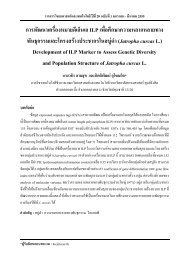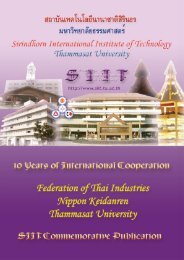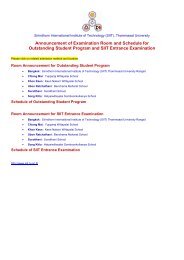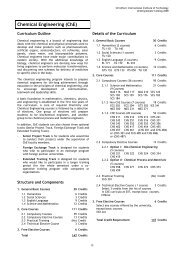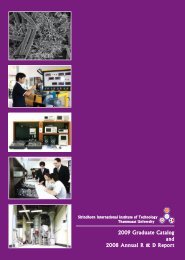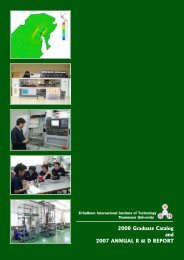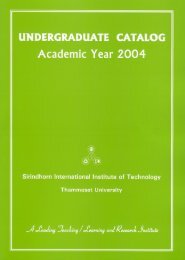2006 Graduate Catalog and 2005 Annual R & D Report - Sirindhorn ...
2006 Graduate Catalog and 2005 Annual R & D Report - Sirindhorn ...
2006 Graduate Catalog and 2005 Annual R & D Report - Sirindhorn ...
Create successful ePaper yourself
Turn your PDF publications into a flip-book with our unique Google optimized e-Paper software.
<strong>2006</strong> <strong>Graduate</strong> <strong>Catalog</strong> <strong>and</strong> <strong>2005</strong> <strong>Annual</strong> R & D <strong>Report</strong><br />
<strong>Sirindhorn</strong> International Institute of Technology (SIIT)<br />
Research Interests:<br />
Asian Monetary <strong>and</strong> Financial Cooperation<br />
The 1997 Asian Crisis underscored the<br />
interdependence among Asian countries <strong>and</strong> the<br />
importance of regional cooperation in managing the<br />
challenges of globalization. Since the Asian Crisis,<br />
there have been moves to enhance monetary <strong>and</strong><br />
financial cooperation – especially among ASEAN+3<br />
countries (ASEAN countries, Japan, China, <strong>and</strong><br />
South Korea) – through information exchange <strong>and</strong><br />
policy dialogue, a regional liquidity support facility,<br />
<strong>and</strong> efforts to develop regional bond markets. The<br />
research focuses on cooperative efforts in the area of<br />
monetary policy <strong>and</strong> finance. It follows progress in<br />
monetary <strong>and</strong> financial integration in Asia, <strong>and</strong><br />
scrutinizes empirical evidence on monetary <strong>and</strong><br />
financial integration. It looks at key issues in limiting<br />
possible risks associated with regionalism <strong>and</strong><br />
possible ways in using integration as a way to reduce<br />
vulnerability to external shocks <strong>and</strong> financial<br />
contagion.<br />
International Capital Flow <strong>and</strong> Foreign Exchange<br />
The late 1980s marked the opening era of financial<br />
liberalization in developing economies. Capital<br />
Controls were abolished, <strong>and</strong> capital flowed freely<br />
across borders. On the one h<strong>and</strong>, this creates<br />
opportunities for developing countries to access<br />
international capital for their economic development.<br />
On the other h<strong>and</strong>, financial flows are volatile <strong>and</strong><br />
herd-like, bringing risks to those developing countries<br />
that overly borrow from the international capital<br />
market as witnessed in the 1982 Latin American Debt<br />
Crisis, the 1994 Mexican Crisis, the 1997-98 Asian<br />
Crisis, the 1998 Russian Crisis, <strong>and</strong> the 2001<br />
Argentinian Crisis. As the key determinant of foreign<br />
exchange rates has shifted away from trade flow to<br />
financial flow, foreign exchange markets are<br />
increasingly volatile. The research looks at evidence<br />
on capital account liberalization in developing<br />
countries, focusing on the relationship between<br />
international capital flow <strong>and</strong> foreign exchange<br />
fluctuations. It analyses the means to manage capital<br />
flows such as Tobin Tax <strong>and</strong> Chilean-style capital<br />
controls as measures to prevent sudden capital<br />
reversal.<br />
Dr. Junalux Chalidabhongse<br />
Assistant Professor<br />
B.Eng. in Computer Engineering, Chulalongkorn University, Thail<strong>and</strong><br />
M.S. in Management Science, California State University at Fullerton, USA<br />
M.S. in Engineering-Economic Systems, Stanford University, CA, USA<br />
Ph.D. in Engineering-Economic Systems <strong>and</strong> Operations Research, Stanford University, CA, USA<br />
Areas of Specialization: Computational organizational modeling, Organizational learning, Organizational<br />
decision making, Decision support systems.<br />
Research Interest:<br />
Computational Organizational Modeling<br />
In order to examine how groups, organizations, <strong>and</strong><br />
societies change over time, the ideas from<br />
organizational theory, sociology, psychology,<br />
management science, <strong>and</strong> intelligent systems have<br />
been combined to develop a computational model<br />
that can be used to represent organizational<br />
dynamics. By applying computational models of<br />
organizations, the behavior in organizations <strong>and</strong> the<br />
interaction among organizations can be studied <strong>and</strong><br />
analyzed through the use of computer simulation.<br />
Research on computational organizational modeling is<br />
composed of two main components. First, it includes<br />
the study to advance underst<strong>and</strong>ing of problemsolving<br />
in human groups, ranging from small<br />
cooperative teams to large-scale, highly-distributed<br />
enterprises: organizational decision making, strategic<br />
business planning, <strong>and</strong> adaptive crisis response in<br />
organizations. Second, the research includes the<br />
development of computer-based technology to<br />
support organizational decision making <strong>and</strong> problem<br />
solving. The research focuses on the design,<br />
development, <strong>and</strong> evaluation of computer-based<br />
intelligent systems that aid organizational decisionmakers<br />
in coordinating their efforts to solve complex<br />
problems.<br />
Dr. Pornpimol Chongphaisal<br />
Lecturer<br />
B.B.A. in Marketing, Assumption University, Thail<strong>and</strong><br />
M.A. in Comparative Management, Ritsumeikan University, Japan<br />
Ph.D. in Management, Ritsumeikan University, Japan<br />
Areas of Specialization: Intercorporate relations, Competencies <strong>and</strong> their applications in Human Resources<br />
Management, Organizational Behavior <strong>and</strong> Development.<br />
28




